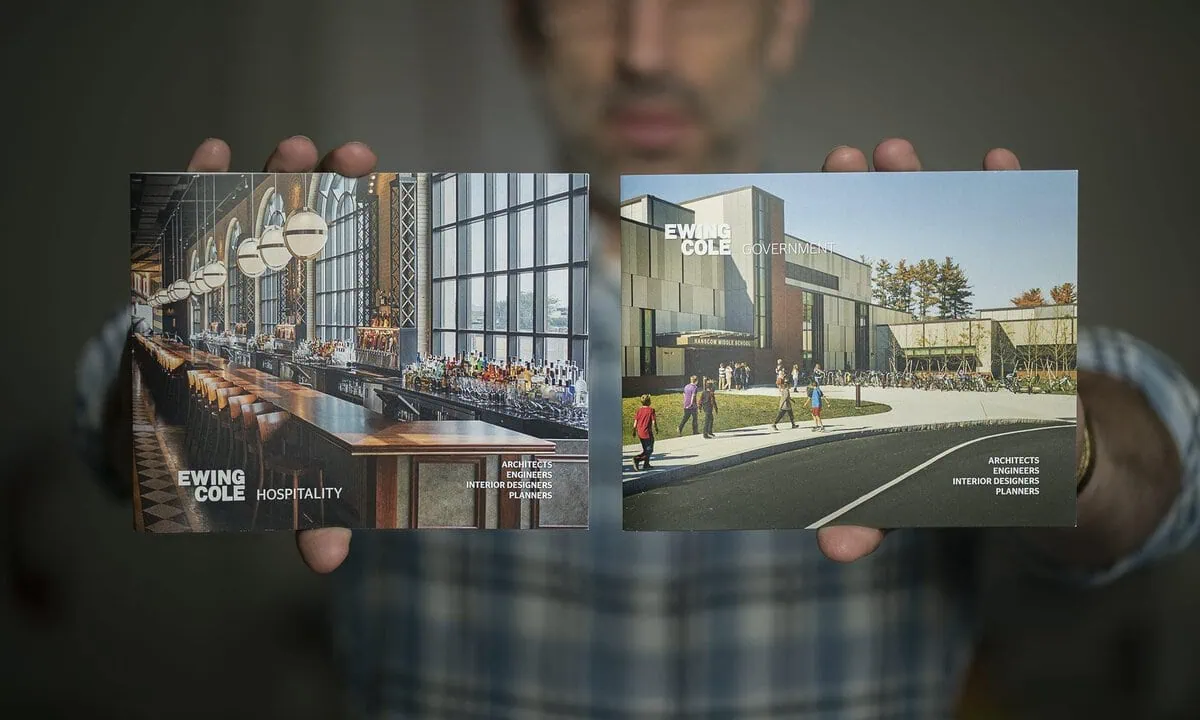In a world dominated by digital media and screens, print design might seem like a relic of the past. However, the truth is far from that. Print design continues to thrive and evolve in exciting ways. In fact, we’d argue it’s never been a better time for print. The technology has evolved so much and we are able to do so much more in an effective way that companies are loving printed materials more than ever!
It’s a medium that allows for a tangible and lasting connection with your audience, making it an essential part of any comprehensive marketing strategy.
With all of that in mind, we put this post together to help you stay in tune with the latest trends and possibilities.
1. Minimalism with a Twist
Minimalism has been a prominent trend in print design for several years now, showing no signs of slowing down. Clean lines, ample white space, and simple typography create a timeless and elegant look that can convey a sense of sophistication. However, what’s changing in the world of minimalism is the addition of a twist.
Print designers are experimenting with unexpected color palettes, unique textures, and subtle gradients to give their minimalistic designs a fresh and contemporary edge. By combining the simplicity of minimalism with a touch of creativity, you can create print materials that stand out and capture attention.
2. Sustainability and Eco-Friendly Design
Sustainability is no longer just a buzzword; it’s a way of life. Consumers are increasingly conscious of their environmental footprint, which has spilled over into print design. Eco-friendly materials, such as recycled paper and soy-based inks, are becoming the norm in print design.
Designers are also incorporating sustainability themes into their work. Earthy color palettes, nature-inspired graphics, and eco-conscious messaging help convey a commitment to environmental responsibility. When your print materials align with these values, you not only appeal to eco-conscious consumers but also contribute to a greener future.
3. Vintage and Retro Vibes
Nostalgia has a powerful appeal, and designers are harnessing this sentiment by infusing their work with vintage and retro vibes. Whether it’s a nod to the psychedelic ’60s or the bold, vibrant colors of the ’80s, vintage-inspired print designs evoke a sense of nostalgia and familiarity.
To create a successful vintage-inspired design, pay attention to period-specific typography, color schemes, and imagery. These elements can transport your audience to a different era while maintaining a contemporary edge.
4. Handcrafted and Artisanal Aesthetics
In our digital age, there’s a growing appreciation for the handmade and artisanal. Sites like etsy and eBay have inspired a generation of creatives and makers to show off their skills. Many print designers are embracing this trend by incorporating hand-drawn illustrations, custom typography, and tactile textures into their work. These elements add a personal and human touch to print materials, making them feel more authentic and unique.
5. Interactive Print
Print design doesn’t have to be static. Thanks to advances in printing technology, designers can now create interactive print materials. QR codes, augmented reality (AR), and even NFC (Near Field Communication) tags can be integrated into print materials to provide additional content, such as videos, product information, or interactive experiences when scanned with a smartphone or tablet.
This interactive element engages the audience and bridges the gap between print and digital media, offering a seamless and memorable experience.
6. Bold Typography and Type Play
Typography has always been a critical element in print design, but in recent years, designers have been pushing the boundaries. Bold, eye-catching typography is taking center stage, with large and expressive fonts making a statement.
Today’s consumer is distracted. Bold Typography is a way of being bold!
Type play, which involves manipulating and distorting text for artistic effect, is also gaining popularity. Creative typography can turn a simple message into a work of art, capturing the viewer’s attention and imagination.
7. Personalization and Variable Data Printing
Personalization is a powerful tool in print design. Variable data printing allows you to tailor your print materials to individual recipients, making each piece unique. This level of personalization can significantly enhance the impact of your print marketing efforts, leading to higher engagement and conversion rates.
By staying current with these trends and adapting them to your brand’s identity and message, you can create print materials that captivate your audience and leave a lasting impression in a world increasingly dominated by digital media.
Remember, the key to successful print design is to strike a balance between timeless principles and innovative, contemporary approaches.
We hope you found this post helpful! If you’re looking for a printer in Philadelphia that can help you strategize for more effective print projects, consider reaching out to the team at RoyerComm!
Request a Quote
Over the years we have accumulated a lot of knowledge about how to create compelling impactful marketing communications. We are here to answer any questions you might have or offer guidance to help take your project from good to GREAT! Give us a call today.
